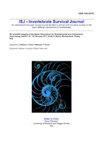Comparative characterization of bacterial communities in digestive glands of Crassostrea gigas fed with different microalgal diets
IF 1.2
4区 农林科学
Q4 IMMUNOLOGY
引用次数: 2
Abstract
The digestive glands of marine molluscs are colonized by a large number of microorganisms, and the structure and function of bacterial community could be severely affected by diets. Microalgae is the main food and energy sources for bivalves, while the impact of phytoplankton composition on the bacterial community as well as the health of bivalves are still not well understood. In the present study, the bacterial communities in digestive glands of oyster Crassostrea gigas fed with different diets were compared based on the high-throughput sequencing of partial 16S rRNA gene. There were significant differences of bacterial composition rather than diversity in digestive glands between the oysters fed with diatom dominant diet (Group N, mainly made up of Nitzschia closterium f.minutissima) and dinoflagellate dominant diet (Group P, mainly made up of Prorocentrum micans). The abundances of Prevotella, Vibronaceae, Ruminococcaceae, and Polaribacter were significantly higher in Group N (p < 0.05), and the abundances of Streptophyta and Acidimicrobiales were significantly higher in Group P (p < 0.05). According to the functional prediction results, the bacterial community in Group P displayed weaker capacities of Kdo2-lipid A biosynthesis as well as taurine degradation, and a stronger capacity of glycolysis compared with the bacterial community in Group N. The higher phylogenetic clustering degree of the bacterial community in Group P (p < 0.05) indicated the higher host selectivity on bacteria. These results suggested that the change of phytoplankton composition of diet would have large effects on bacterial communities in oyster digestive glands. The bacterial community in digestive glands of oysters living in dinoflagellate dominant waters would produce harmful impact to hosts. The present study provided a new perspective to explore the potential mechanism for the massive mortalities of oysters.饲喂不同微藻饲料的长牡蛎消化腺细菌群落的比较研究
海洋软体动物的消化腺中有大量的微生物定植,其细菌群落的结构和功能会受到饲料的严重影响。微藻是双壳类的主要食物和能量来源,而浮游植物组成对双壳类细菌群落和健康的影响尚不清楚。本研究通过对部分16S rRNA基因的高通量测序,比较了不同饲料条件下牡蛎长牡蛎消化腺内的细菌群落。以硅藻为优势饲料(N组,主要为微小梭状芽孢杆菌)和鞭毛藻为优势饲料(P组,主要为micans原心菌)饲养的牡蛎,其消化腺细菌组成差异显著,但多样性差异不显著。Prevotella、Vibronaceae、Ruminococcaceae和Polaribacter的丰度在N组显著高于(p < 0.05), streptopyta和Acidimicrobiales的丰度在p组显著高于(p < 0.05)。功能预测结果显示,与n组相比,P组细菌群落的kdo2 -脂质A生物合成能力和牛磺酸降解能力较弱,糖酵解能力较强,P组细菌群落的系统发育聚类程度较高(P < 0.05),表明P组细菌群落对细菌具有较高的寄主选择性。上述结果表明,饵料中浮游植物组成的变化对牡蛎消化腺细菌群落有较大影响。生活在鞭毛藻优势水域的牡蛎的消化腺细菌群落会对宿主产生有害影响。本研究为探讨牡蛎大量死亡的潜在机制提供了新的视角。
本文章由计算机程序翻译,如有差异,请以英文原文为准。
求助全文
约1分钟内获得全文
求助全文
来源期刊

ISJ-Invertebrate Survival Journal
IMMUNOLOGY-ZOOLOGY
CiteScore
2.10
自引率
0.00%
发文量
0
审稿时长
>12 weeks
期刊介绍:
Invertebrate Survival Journal (ISJ) is an international and open access journal devoted to prompt and innovative studies on the basic defense mechanisms in invertebrates, in particular with a view to identifying biotechnologies able to act against derived diseases and related economic damage.
Contributions will be mainly in the form of Letters to the Editor, Visions and Perspectives, Short Communications, Technical Reports, Research Reports, Review, Minireview and Reports of Meetings. Letters to the Editor can be commentaries or perspectives on invertebrate defence mechanisms or replies to the data published in ISJ.
 求助内容:
求助内容: 应助结果提醒方式:
应助结果提醒方式:


